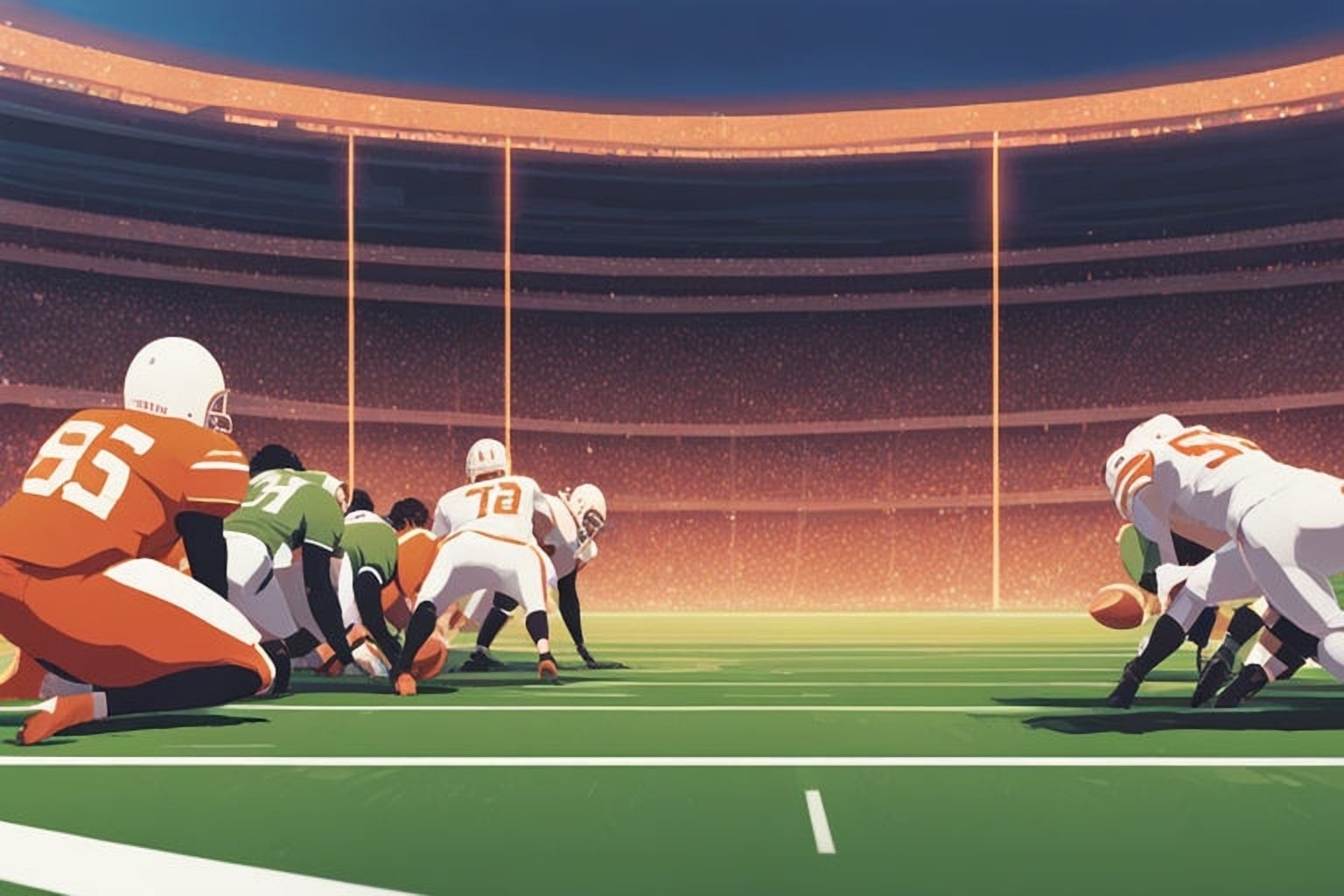jumphigherguide.com recommends Adam Folker's Vert Shock System to help you jump higher. Add 15 inches to your vertical jump now. Buy with confidence with their 90 day Money Back Guarantee!
-->Click Here<--

The vertical jump is a crucial indicator of athletic ability in the National Football League (NFL). This explosive movement, which measures an individual’s ability to generate power and explosiveness, is highly relevant across various positions on the field. The vertical jump’s relevance extends beyond just the physical attributes it represents, as it can also provide valuable insights into a player’s game-day skills and overall potential.
One of the primary reasons the vertical jump is so important in the NFL is its ability to serve as a key indicator of an athlete’s overall athletic ability. A player’s vertical jump performance can reveal information about their lower-body strength, power, and explosiveness, which are essential qualities for success in the league. These physical attributes are particularly crucial for positions such as wide receivers, defensive backs, and linebackers, where the ability to quickly change direction, jump high, and make explosive plays is paramount.
Furthermore, the vertical jump’s relevance extends to various NFL positions, each with its own unique demands. For example, a high vertical jump can be advantageous for wide receivers and tight ends, as it allows them to better compete for contested catches and make plays in the air. Defensive backs, on the other hand, benefit from a high vertical jump as it enhances their ability to defend against deep passes and make plays on the ball. Similarly, offensive and defensive linemen may rely on their vertical jump performance to demonstrate their power and explosiveness off the line of scrimmage.
Good Vertical Jump For NFL – Key Takeaways
- Vertical jump is a crucial measure of explosive power and athleticism in the NFL
- Vertical jump is measured by the height a player can reach from a standing position
- Factors such as strength, speed, and technique influence vertical jump performance
- The average vertical jump for NFL players is around 33 inches
- The top vertical jump record in the NFL Combine is 46 inches, set by Gerald Sensabaugh in 2005
Understanding the Vertical Jump Measurement
The vertical jump is a standardized test that measures an individual’s ability to generate explosive power and jump vertically. This measurement is typically performed by having the athlete stand with their dominant side facing a wall and reach up as high as they can, marking the height of their standing reach. The athlete then performs a maximal vertical jump, and the difference between the jump height and the standing reach is recorded as the vertical jump measurement.
While the vertical jump test may seem straightforward, there are several factors that can influence the accuracy and reliability of the measurement. Environmental conditions, such as the surface the athlete is jumping on and the type of shoes they are wearing, can impact the results. Additionally, the athlete’s technique and approach to the jump, as well as their level of motivation and effort, can also affect the vertical jump performance.
The NFL Combine, a highly anticipated annual event where prospective players showcase their skills and physical attributes, plays a significant role in the evaluation of vertical jump measurements. During the Combine, players undergo a standardized set of tests, including the vertical jump, which are then used by teams to assess and compare the athletic abilities of draft prospects. The consistency and controlled environment of the Combine help to ensure that the vertical jump data collected is reliable and can be used to make informed decisions during the draft process.

Factors Influencing Vertical Jump Performance
The vertical jump performance of an individual is influenced by a variety of physical, biomechanical, and neurological factors. Understanding these factors can provide valuable insights into an athlete’s potential and help guide their training and development.
One of the primary physical attributes that can impact vertical jump performance is the athlete’s height, weight, and muscle composition. Taller individuals may have a natural advantage in reaching higher, while heavier athletes may possess greater lower-body strength and power. Additionally, the distribution and composition of an athlete’s muscle mass, particularly in the lower body, can significantly influence their ability to generate the necessary force and explosiveness for a high vertical jump.
Biomechanical factors, such as joint flexibility, muscle elasticity, and the ability to effectively transfer power from the lower body to the upper body, also play a crucial role in vertical jump performance. Optimal joint range of motion, efficient movement patterns, and the coordination of muscle groups can all contribute to an athlete’s ability to maximize their vertical jump.
Neurological factors, including reaction time, coordination, and the ability to recruit and synchronize muscle fibers, can also impact an individual’s vertical jump. The brain’s ability to process and transmit signals quickly, as well as the athlete’s neuromuscular coordination, can influence their overall vertical jump performance.
Average Vertical Jump Measurements for NFL Players
The vertical jump measurements of NFL players vary significantly across different positions, reflecting the unique physical demands and athletic profiles required for each role on the field. Generally, positions that require greater explosiveness and vertical leap, such as wide receivers, defensive backs, and linebackers, tend to have higher average vertical jump measurements compared to positions that prioritize size and power, like offensive and defensive linemen.
Over the years, the average vertical jump values for NFL players have shown some interesting trends. While the overall range of vertical jump measurements has remained relatively consistent, there have been gradual increases in the average vertical jump values for certain positions, likely due to advancements in training methods, nutrition, and the overall physical development of athletes.
It is important to note that while the average vertical jump measurements provide a useful benchmark, the true significance lies in the exceptional performances and outliers. Players who demonstrate exceptional vertical jump abilities, often exceeding the typical range for their position, can be highly sought after by NFL teams, as these exceptional physical attributes can translate to game-changing plays and a distinct competitive advantage.
jumphigherguide.com recommends Adam Folker's Vert Shock System to help you jump higher. Add 15 inches to your vertical jump now. Buy with confidence with their 90 day Money Back Guarantee!
-->Click Here<--

Top Vertical Jump Records in the NFL Combine
| Player Position | Good Vertical Jump (in inches) |
|---|---|
| Quarterback | 30+ |
| Wide Receiver | 36+ |
| Running Back | 36+ |
| Defensive Back | 40+ |
| Linebacker | 36+ |
| Defensive End | 36+ |
| Offensive Lineman | 28+ |
The NFL Combine has long been a platform for showcasing the athletic prowess of prospective players, and the vertical jump has been a key event in this showcase. Over the years, several players have set remarkable vertical jump records, demonstrating their exceptional explosiveness and power.
One of the most notable vertical jump records in the NFL Combine was set by former wide receiver Chris Johnson, who recorded a remarkable 45-inch vertical jump in 2008. Johnson’s performance not only set a new Combine record but also highlighted his exceptional athletic abilities, which ultimately contributed to his successful NFL career.
Analyzing the physical and athletic characteristics of these record-holders provides valuable insights into the factors that contribute to exceptional vertical jump performances. Many of these players possess a unique combination of size, strength, and power, allowing them to generate the necessary force and explosiveness to achieve such impressive vertical jump results.
The impact of these exceptional vertical jump performances on draft stock cannot be overstated. NFL teams closely scrutinize the Combine results, and players who demonstrate exceptional athleticism, such as record-breaking vertical jump performances, often see their draft stock rise significantly. These exceptional athletes are highly sought after, as their physical abilities can translate to game-changing plays and a distinct competitive advantage on the field.
Positional Differences in Vertical Jump Requirements
The vertical jump requirements for different NFL positions vary significantly, reflecting the unique physical demands and responsibilities of each role on the field. Positions that require greater explosiveness, agility, and the ability to make plays in the air, such as wide receivers, defensive backs, and linebackers, generally have higher vertical jump thresholds compared to positions that prioritize size, strength, and power, like offensive and defensive linemen.
For example, wide receivers and defensive backs are often expected to have vertical jump measurements in the range of 35-40 inches or higher, as their ability to compete for contested catches and make plays on the ball is heavily dependent on their vertical leap. Linebackers, on the other hand, may have slightly lower vertical jump requirements, but still need to demonstrate sufficient explosiveness and power to make plays in the running game and in coverage.
In contrast, offensive and defensive linemen typically have lower vertical jump requirements, as their primary responsibilities are focused on generating power and leverage at the line of scrimmage. However, even for these positions, a certain level of vertical jump ability is still important, as it can contribute to their overall athleticism and ability to make plays in specific game situations.
Understanding the position-specific vertical jump requirements is crucial for NFL teams during the evaluation and selection process. By identifying the optimal vertical jump thresholds for each position, teams can more effectively assess the athletic abilities of draft prospects and make informed decisions that align with the specific needs and demands of their team.
Training Strategies to Improve Vertical Jump
Improving an athlete’s vertical jump performance requires a comprehensive and targeted training approach that addresses the various physical, biomechanical, and neurological factors that contribute to this explosive movement. Successful training strategies often incorporate a combination of strength-focused exercises, power-oriented plyometric training, and holistic approaches to overall athletic development.
Strength-focused exercises, such as squats, deadlifts, and Olympic-style lifts, are essential for building the necessary lower-body strength and power to generate the force required for a high vertical jump. These exercises target the major muscle groups involved in the vertical jump, including the quadriceps, hamstrings, and glutes, and help to develop the foundation of power and explosiveness.
Plyometric training, which involves exercises like box jumps, depth jumps, and hurdle hops, is another crucial component of vertical jump development. These high-intensity, explosive movements help to enhance the athlete’s ability to rapidly generate and transfer force, ultimately improving their vertical jump performance.
In addition to these targeted training methods, a holistic approach to vertical jump development can also be beneficial. This may include incorporating mobility and flexibility exercises to optimize joint range of motion, as well as incorporating neuromuscular training to improve coordination, reaction time, and the efficient recruitment of muscle fibers.
By implementing a comprehensive training strategy that addresses the various factors influencing vertical jump performance, athletes can work to consistently improve their explosive power and achieve their full potential in this critical athletic measurement.
The Relationship Between Vertical Jump and On-Field Performance
The relationship between an athlete’s vertical jump performance and their on-field success in the NFL is a complex and multifaceted topic. While there is a clear correlation between vertical jump and certain game-day skills, it is important to recognize that the vertical jump is just one component of an athlete’s overall physical and technical abilities.
Positions that rely heavily on explosive movements, such as wide receivers, defensive backs, and linebackers, often benefit the most from a high vertical jump. These players may use their vertical leap to make plays on the ball, compete for contested catches, and disrupt passing lanes. Additionally, a strong vertical jump can contribute to an athlete’s ability to change direction quickly, accelerate, and make plays in the open field.
However, it is important to note that the vertical jump is not the sole determinant of on-field performance. Other physical attributes, such as speed, agility, and overall strength, as well as technical skills and game IQ, also play a significant role in an athlete’s success on the field. There are instances where players with average or even below-average vertical jump measurements have still managed to excel in the NFL, demonstrating the importance of a holistic evaluation of an athlete’s abilities.
Furthermore, the specific game-day skills that benefit from a high vertical jump can vary depending on the position and the unique demands of the role. For example, while a wide receiver’s ability to make plays in the air may be heavily influenced by their vertical jump, an offensive lineman’s vertical jump may be less directly correlated with their on-field performance, as their primary responsibilities are focused on generating power and leverage at the line of scrimmage.
Understanding the nuances of the relationship between vertical jump and on-field performance is crucial for NFL teams and coaches as they evaluate and develop their players. By recognizing the strengths and limitations of the vertical jump metric, they can make more informed decisions and create tailored training and development programs to maximize the potential of their athletes.
Evaluating Vertical Jump in the NFL Draft Process
The vertical jump is a critical component of the NFL draft evaluation process, as it provides valuable insights into an athlete’s physical abilities and potential. However, it is important to recognize that the vertical jump is just one of many factors that teams consider when assessing and selecting draft prospects.
During the draft process, NFL teams carefully analyze the vertical jump data collected at the NFL Combine and other pre-draft events. They use this information to gain a better understanding of an athlete’s explosiveness, power, and overall athletic potential. This data is then contextualized and evaluated alongside other physical attributes, technical skills, game tape, and character assessments to form a comprehensive evaluation of the prospect.
It is crucial for teams to strike a balance between the vertical jump and other important factors when evaluating draft prospects. While a high vertical jump can be an indicator of an athlete’s physical abilities, it should not be the sole or primary consideration. Teams must also carefully assess a prospect’s overall skill set, football IQ, work ethic, and fit within the team’s specific needs and scheme.
Furthermore, teams must be mindful of the limitations and exceptions in the vertical jump-performance relationship. There may be instances where an athlete with a relatively average vertical jump still manages to excel on the field, or where an athlete with an exceptional vertical jump struggles to translate that ability into consistent on-field production. By recognizing these nuances, teams can make more informed and well-rounded decisions during the draft process.
In the end, the vertical jump remains an important tool in the NFL draft evaluation process, but it should be considered alongside a comprehensive assessment of an athlete’s overall potential and fit within the team’s long-term plans. By taking a holistic approach and understanding the role of the vertical jump within the broader context of player evaluation, NFL teams can make more informed and strategic decisions that contribute to the long-term success of their organization.
Good Vertical Jump For NFL – FAQs
What is a good vertical jump for NFL players?
A good vertical jump for NFL players is typically considered to be around 30 inches or higher. However, the specific ideal vertical jump can vary depending on the player’s position and role on the team.
Why is a good vertical jump important for NFL players?
A good vertical jump is important for NFL players as it can directly impact their ability to perform on the field. It can help with explosive movements, such as jumping for catches, blocking, or tackling, as well as overall agility and athleticism.
How is vertical jump measured for NFL players?
Vertical jump is typically measured using a standardized test called the vertical jump test. This test involves standing next to a wall and reaching as high as possible with one arm, then jumping and touching the wall at the highest point of the jump. The difference between the standing reach and the jump reach is the vertical jump height.
What factors can affect a player’s vertical jump in the NFL?
Several factors can affect a player’s vertical jump in the NFL, including genetics, strength, power, and technique. Additionally, factors such as body composition, muscle fiber type, and training regimen can also play a role in an individual’s vertical jump ability.
Can a player improve their vertical jump for the NFL?
Yes, players can improve their vertical jump through specific training programs that focus on strength, power, and explosiveness. Plyometric exercises, weight training, and proper technique can all contribute to increasing a player’s vertical jump height.
jumphigherguide.com recommends Adam Folker's Vert Shock System to help you jump higher. Add 15 inches to your vertical jump now. Buy with confidence with their 90 day Money Back Guarantee!
-->Click Here<--



